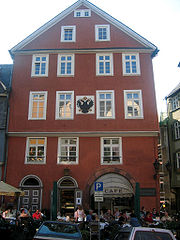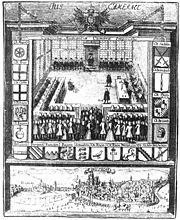
Reichskammergericht
Encyclopedia

Holy Roman Empire
The Holy Roman Empire was a realm that existed from 962 to 1806 in Central Europe.It was ruled by the Holy Roman Emperor. Its character changed during the Middle Ages and the Early Modern period, when the power of the emperor gradually weakened in favour of the princes...
, the other one being the Aulic Council
Aulic Council
The Aulic Council was originally an executive-judicial council for the Holy Roman Empire....
in Vienna. It was founded in 1495 by the Imperial Diet
Reichstag (Holy Roman Empire)
The Imperial Diet was the Diet, or general assembly, of the Imperial Estates of the Holy Roman Empire.During the period of the Empire, which lasted formally until 1806, the Diet was not a parliament in today's sense; instead, it was an assembly of the various estates of the realm...
in Worms
Worms, Germany
Worms is a city in Rhineland-Palatinate, Germany, on the Rhine River. At the end of 2004, it had 85,829 inhabitants.Established by the Celts, who called it Borbetomagus, Worms today remains embattled with the cities Trier and Cologne over the title of "Oldest City in Germany." Worms is the only...
. All legal proceedings in the Holy Roman Empire could be brought to the Imperial Chamber Court, except if the ruler of the territory had a so-called privilegium de non appellando
Privilegium de non appellando
The Latin-originating phrase "privilegium de non appellando" words meaning "privilege of not be appealed". The phrase denotes the status by which a person or an institution is exempted from the jurisdiction of the judiciary in matters of appeal, in which a lower court's decision has its...
, in which case the highest judicial institution was found by the ruler of that territory. Another exception was criminal law. The Imperial Chamber Court could only intervene in criminal cases if basic procedural rules had been violated.
The Imperial Chamber Court was infamous for the long time it took to reach a verdict. Some proceedings, especially in lawsuits between different states of the Empire, took several hundred years. Some of the lawsuits were not brought to an end by the time it was dissolved in 1806 following the downfall of the Holy Roman Empire. Yet, lately it has been discovered that this could often be attributed to a loss of interest on the part of the parties involved, and that the court could sometimes be much more efficient than previously thought. Sometimes the court even ordered injunctions within a few days.
Recent research also brought to light that, especially in the 18th century, the rulings of the court anticipated in many ways the constitutional establishment of civil liberties in Germany. For instance, the inviolability of one's housing or freedom of trade were legally introduced in the Empire by rulings of the court. At the end of the 18th century some contemporaries even compared the Imperial Chamber Court to the National Assembly
National Assembly (French Revolution)
During the French Revolution, the National Assembly , which existed from June 17 to July 9, 1789, was a transitional body between the Estates-General and the National Constituent Assembly.-Background:...
in Revolutionary France.
History
At its foundation the court was seated in FrankfurtFrankfurt
Frankfurt am Main , commonly known simply as Frankfurt, is the largest city in the German state of Hesse and the fifth-largest city in Germany, with a 2010 population of 688,249. The urban area had an estimated population of 2,300,000 in 2010...
, but was later moved to Worms
Worms, Germany
Worms is a city in Rhineland-Palatinate, Germany, on the Rhine River. At the end of 2004, it had 85,829 inhabitants.Established by the Celts, who called it Borbetomagus, Worms today remains embattled with the cities Trier and Cologne over the title of "Oldest City in Germany." Worms is the only...
, Augsburg
Augsburg
Augsburg is a city in the south-west of Bavaria, Germany. It is a university town and home of the Regierungsbezirk Schwaben and the Bezirk Schwaben. Augsburg is an urban district and home to the institutions of the Landkreis Augsburg. It is, as of 2008, the third-largest city in Bavaria with a...
, Nürnberg, Regensburg
Regensburg
Regensburg is a city in Bavaria, Germany, located at the confluence of the Danube and Regen rivers, at the northernmost bend in the Danube. To the east lies the Bavarian Forest. Regensburg is the capital of the Bavarian administrative region Upper Palatinate...
, Speyer
Speyer
Speyer is a city of Rhineland-Palatinate, Germany with approximately 50,000 inhabitants. Located beside the river Rhine, Speyer is 25 km south of Ludwigshafen and Mannheim. Founded by the Romans, it is one of Germany's oldest cities...
, Esslingen, again Speyer (1527 to 1689) and finally to Wetzlar
Wetzlar
Wetzlar is a city in the state of Hesse, Germany. Located at 8° 30′ E, 50° 34′ N, Wetzlar straddles the river Lahn and is on the German Timber-Framework Road which passes mile upon mile of half-timbered houses. Historically, the city has acted as the hub of the Lahn-Dill-Kreis on the north edge of...
until it was dissolved in 1806.

Holy Roman Emperor
The Holy Roman Emperor is a term used by historians to denote a medieval ruler who, as German King, had also received the title of "Emperor of the Romans" from the Pope...
himself presided. This court was connected directly to the Emperor, so it ceased to act when he was abroad and disbanded when he died. In the 15th century, the Emperor ceased to command as much respect, so his court lost the confidence of his subjects. Its place was taken by the Kammergericht.
The Emperor or a deputy still presided in the court and it was still his personal court; but the members were now officials of the Empire. It was generally the legal members of the council who sat in the Kammergericht. The Kammergericht fell into disuse in the later years of the reign of Frederick III
Frederick III, Holy Roman Emperor
Frederick the Peaceful KG was Duke of Austria as Frederick V from 1424, the successor of Albert II as German King as Frederick IV from 1440, and Holy Roman Emperor as Frederick III from 1452...
and the creation of a new and efficient court became a matter of pressing necessity, and was one of the most urgent of the reforms which were mooted in the reign of Maximilian I
Maximilian I, Holy Roman Emperor
Maximilian I , the son of Frederick III, Holy Roman Emperor and Eleanor of Portugal, was King of the Romans from 1486 and Holy Roman Emperor from 1493 until his death, though he was never in fact crowned by the Pope, the journey to Rome always being too risky...
.
The "province of the Imperial Chamber", as it came to be gradually defined by statute and use, extended to breaches of the public peace, cases of arbitrary distrait or imprisonment, pleas which concerned the treasury, violations of the Emperor's decrees or the laws passed by the Imperial Diet, disputes about property between immediate tenants of the Empire or the subjects of different rulers, and finally suits against immediate tenants of the Empire, with the exception of criminal charges and matters relating to imperial fiefs, which went to the Aulic Council
Aulic Council
The Aulic Council was originally an executive-judicial council for the Holy Roman Empire....
.
In all its business it suffered from the competition of the Aulic Council; and after the 16th century devoted itself exclusively to judicial work.
Composed of the personal advisers of the Emperor, the Aulic Council did justice on his behalf. The competition between the Aulic Council and the Imperial Chamber was finally regulated by the Treaty of Westphalia in 1648, which laid it down that the court which first dealt with a case should alone have competence to pursue it.
Membership
Membership of the court was determined by both the Holy Roman Emperor and the component states of the Empire. The Emperor named the chief justice, always a high aristocrat, several presidents of the court senates and some of the members of the court. The majority of the judges were selected by the Estates of the realmEstates of the realm
The Estates of the realm were the broad social orders of the hierarchically conceived society, recognized in the Middle Ages and Early Modern period in Christian Europe; they are sometimes distinguished as the three estates: the clergy, the nobility, and commoners, and are often referred to by...
. Originally, half of the judges were Knights of the Empire, and the other half doctors of Roman law
Roman law
Roman law is the legal system of ancient Rome, and the legal developments which occurred before the 7th century AD — when the Roman–Byzantine state adopted Greek as the language of government. The development of Roman law comprises more than a thousand years of jurisprudence — from the Twelve...
, but after 1548 all judges had to be doctors of law.

